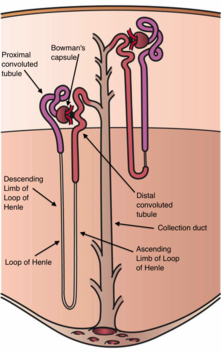| Gitelman syndrome | |
|---|---|
| Other names | Primary renal tubular hypokalemic hypomagnesemia with hypocalciuria |
 | |
| A model of transport mechanisms in the distal convoluted tubule. Sodium chloride (NaCl) enters the cell via the apical thiazide-sensitive NCC and leaves the cell through the basolateral Cl− channel (ClC-Kb), and the Na+/K+-ATPase. Indicated also are the recently identified magnesium channel TRPM6 in the apical membrane, and a putative Na/Mg exchanger in the basolateral membrane. These transport mechanisms play a role in familial hypokalemia-hypomagnesemia or Gitelman syndrome. | |
| Specialty | Nephrology |
| Causes | Mutations in SLC12A3, CLCKNB, MT-TI, MT-TF |

Gitelman syndrome (GS) is an autosomal recessive kidney tubule disorder characterized by low blood levels of potassium and magnesium, decreased excretion of calcium in the urine, and elevated blood pH.[2] It is the most frequent hereditary salt-losing tubulopathy. Gitelman syndrome is caused by disease-causing variants on both alleles of the SLC12A3 gene. The SLC12A3 gene encodes the thiazide-sensitive sodium-chloride cotransporter (also known as NCC, NCCT, or TSC), which can be found in the distal convoluted tubule of the kidney.[2][3]
Disease-causing variants in SLC12A3 lead to a loss of NCC function, i.e., reduced transport of sodium and chloride via NCC. The effect is an electrolyte imbalance similar to that seen with thiazide diuretic therapy (which causes pharmacological inhibition of NCC activity).[4]
Gitelman syndrome was formerly considered a subset of Bartter syndrome until the distinct genetic and molecular bases of these disorders were identified.
- ^ Fischer H (2013-01-31), English: This is an image of a kidney nephron and its structure., retrieved 2020-04-01
- ^ a b Nakhoul F, Nakhoul N, Dorman E, Berger L, Skorecki K, Magen D (February 2012). "Gitelman's syndrome: a pathophysiological and clinical update". Endocrine (Review). 41 (1): 53–57. doi:10.1007/s12020-011-9556-0. PMID 22169961. S2CID 5820317.
- ^ Seyberth HW, Schlingmann KP (October 2011). "Bartter- and Gitelman-like syndromes: salt-losing tubulopathies with loop or DCT defects". Pediatric Nephrology. 26 (10): 1789–1802. doi:10.1007/s00467-011-1871-4. PMC 3163795. PMID 21503667.
- ^ Nijenhuis T, Vallon V, van der Kemp AW, Loffing J, Hoenderop JG, Bindels RJ (June 2005). "Enhanced passive Ca2+ reabsorption and reduced Mg2+ channel abundance explains thiazide-induced hypocalciuria and hypomagnesemia". The Journal of Clinical Investigation. 115 (6): 1651–1658. doi:10.1172/JCI24134. PMC 1090474. PMID 15902302.